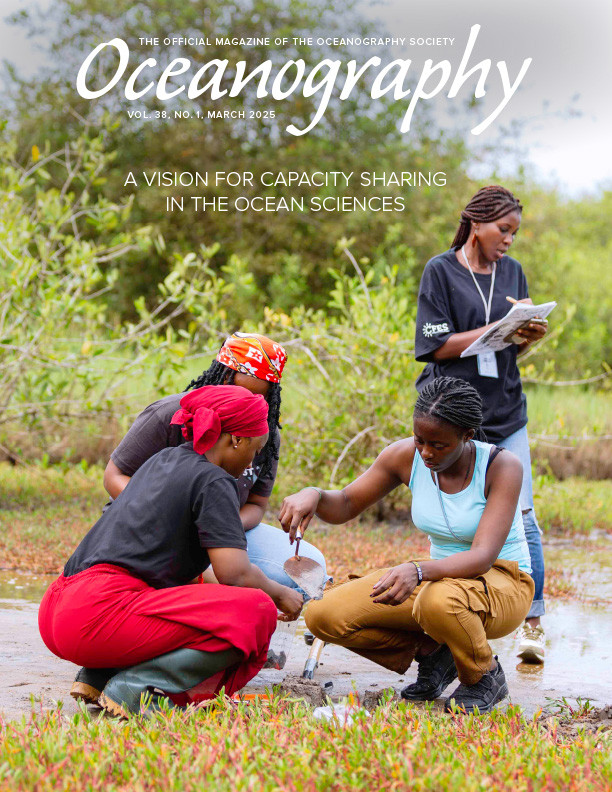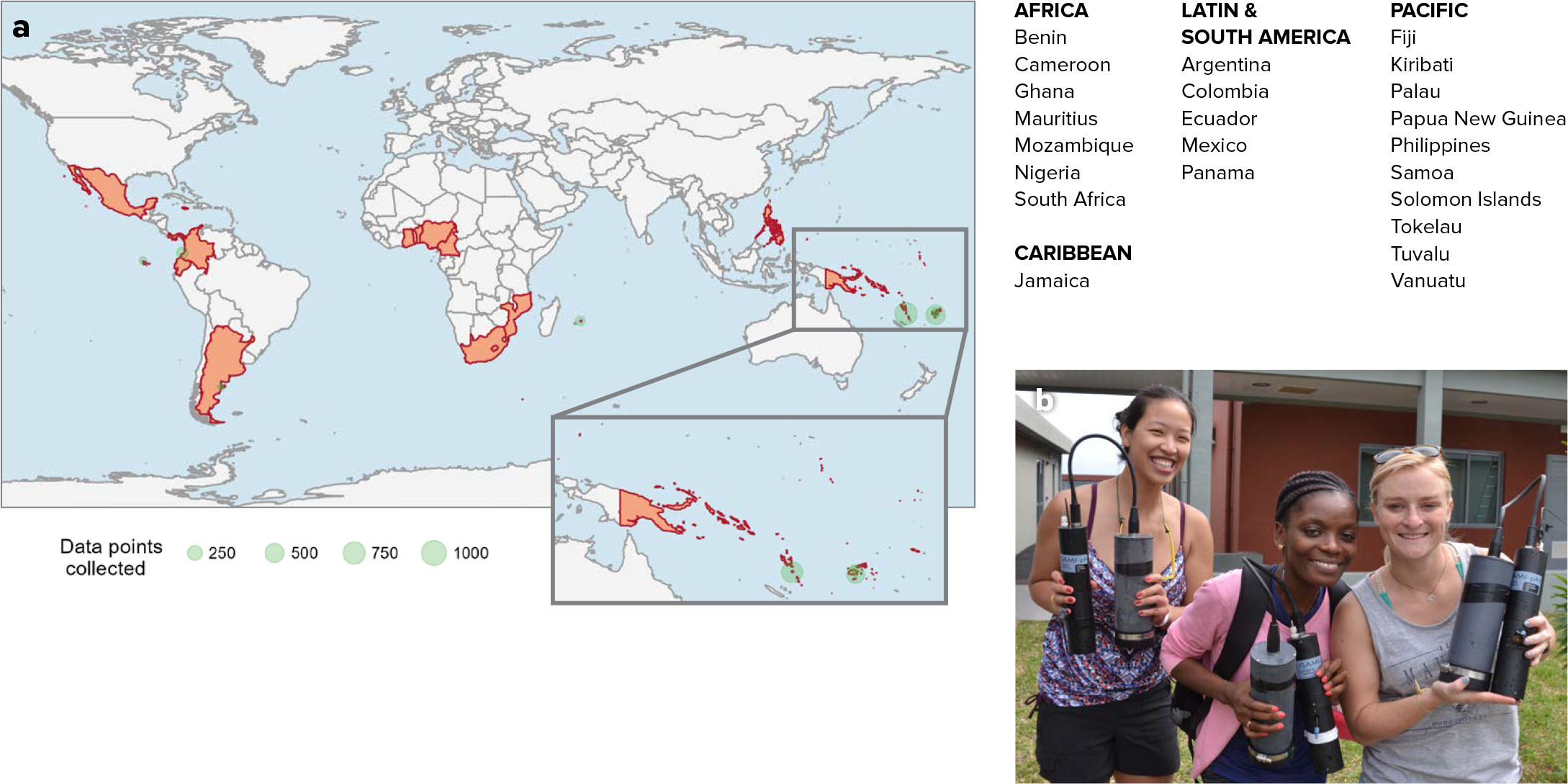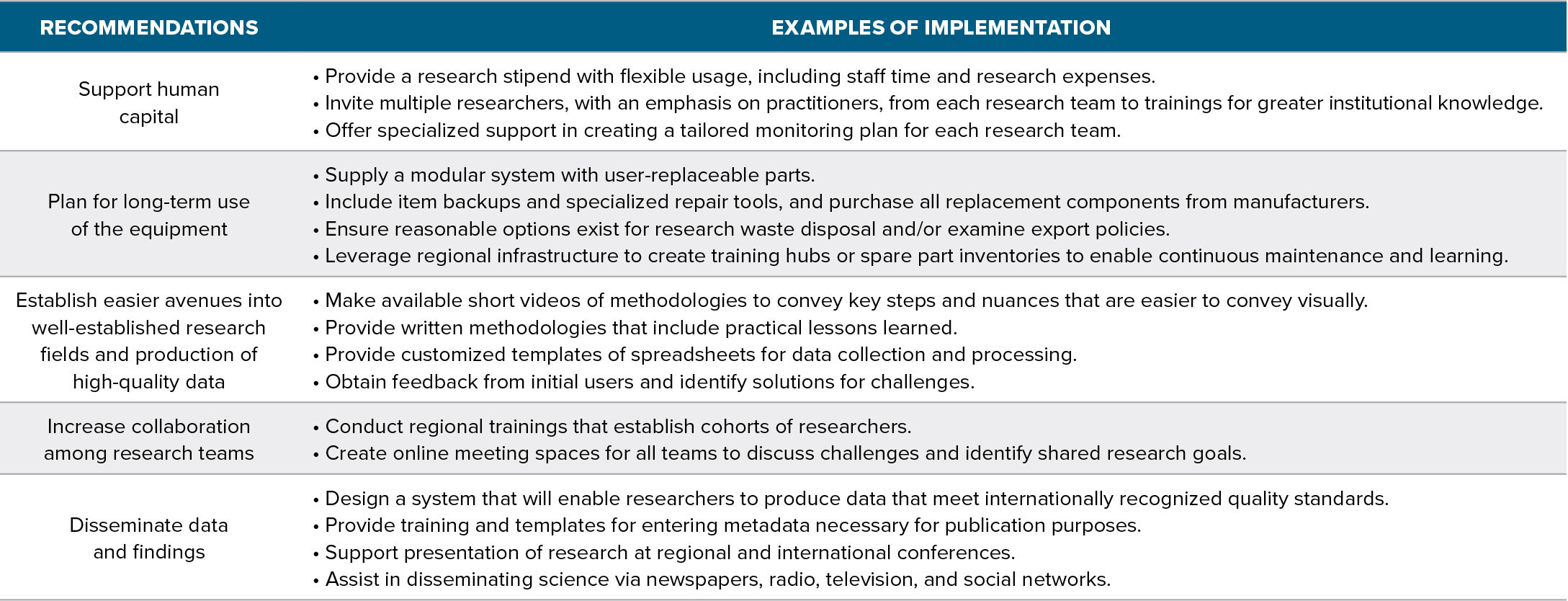Full Text
Addressing Existing Needs for Ocean Acidification Research
Providing reliable instrumentation that enables collection of high-quality, comparable data is one of the most challenging aspects of establishing ocean acidification monitoring programs. This is especially true for under-resourced countries, where such data are mostly unavailable. In 2016, The Ocean Foundation (TOF) worked with international bodies, including the International Atomic Energy Agency’s Ocean Acidification International Coordination Centre and the Global Ocean Acidification Observing Network (GOA-ON), and subject matter experts to develop a set of equipment known as the “GOA-ON in a Box” kit (The Ocean Foundation, 2017). This comprehensive kit provides researchers with everything needed—down to specialized rubber bands—to obtain weather-quality carbonate system measurements as defined by GOA-ON (Newton et al., 2015). Data are generated from spectrophotometric measurements of pHT and manual titrations for total alkalinity from discrete samples as well as in situ sensors, the iSAMI-pH and a CTD. The kit’s modular design, composed of nearly 100 unique items, makes it much less expensive than comparable integrated systems and allows for easier troubleshooting and replacement of supplied spare components.
To date, TOF has procured and shipped GOA-ON in a Box kits to researchers in 23 countries, where they are used to monitor changing ocean carbonate chemistry conditions related to ocean acidification and to produce data in support of United Nations Sustainable Development Goal 14.3.1 (SDG 14.3.1; Figure 1). Kit distribution has been conducted through regional campaigns, driven by funder requirements. Note that TOF consistently receives requests for kits in regions that are outside the scope of current funding.
|
|
Equipment donation alone does not provide sufficient support for nascent ocean acidification monitoring programs. TOF has established a multifaceted approach that supports those who are initiating ocean acidification research (Table 1). Engagement with kit recipients begins with discussions of available laboratory supplies and resources, research goals, and initial knowledge exchange. This startup phase directly shapes subsequent phases, including customization of the GOA-ON in a Box kits and creation of region- and recipient-specific training activities. TOF has organized 10 expert-led, in-person workshops for over 180 participants, creating cohorts of regional users and a foundational hands-on introduction to using the components of the kit both in the laboratory and in the field. Attendees of the in-person workshops report greatly upgraded knowledge and skills in classical and modern methods of monitoring and assessing ocean acidification in marine and coastal waters.
TABLE 1. Increasing capacity for ocean science requires additional investment beyond initial donation of hardware. The Ocean Foundation, other proponents, and users of the GOA-ON in a Box ocean acidification monitoring kit have established an ecosystem of support around the kit, providing a set of guidelines for replications in other oceanographic fields. > High res table |
Along with equipment, the nascent research teams typically receive stipends that support research activity initialization. These funds can be used for a variety of purposes, for example, transport costs to field sites, additional consumables, staff time, or improved laboratory infrastructure. Detailed monitoring plans are set by each team—with advice obtained from training and mentorship programs (e.g., GOA-ON’s Pier2Peer program)—allowing the research questions, frequency, and locations to be established in feasible and sustainable ways.
Planning for sustainability suggests the likelihood that research teams can continue their work beyond an initial period of effort. Over time, the standard kit has been updated as some item models became unavailable from commercial suppliers, and it has been augmented with additional laboratory supplies and extra reagents, such as wash bottles and pH indicator powder. Additionally, the in situ pH sensor’s manufacturer created a tailored maintenance kit complete with specialized components, consumables such as cable ties, and specific tools that are often not readily available in kit recipients’ regions. However, some items have non-user-replaceable batteries or can develop unexpected faults, necessitating long-term troubleshooting support and/or a return to the manufacturer. TOF maintains a network of sensor experts who can provide advice when issues arise. Additionally, research waste must also be dealt with in an environmentally conscious manner aligned with regulations, especially at institutions with limited waste disposal systems. For ocean acidification research, mercuric chloride is a necessary but toxic sample preservative. The GOA-ON in a Box kits now include a filtration setup to concentrate the mercury into a more manageable resin.
Supporting Sustained Ocean Acidification Observations
Teams that are building proficiency in new methodologies can be supported by online, updatable materials. Facilitating consistency in data acquisition and disseminating protocols to new team members is accomplished through short, instructive videos (GOA-ON in a Box Instructional Videos, 2020) with subtitles in four languages (English, French, Spanish, and Portuguese) and a set of step-by-step guides and templates that compose the Practical Best Practices for Ocean Acidification Monitoring (Currie et al., 2024). These materials feature guidance from subject matter experts who generously contributed their time to increase the accessibility of technical methodologies and help alleviate prior issues with kit setup and use.
As researchers progress with their monitoring programs, their data contribute to a global understanding of changing ocean conditions. Sampling for ocean acidification also produces temperature and salinity records that can be added to existing long-term field studies, such as biological monitoring. In addition to scientific publications and presentations, teams can choose to submit their metadata and data in support of the SDG 14.3.1 (https://oa.iode.org/), often providing the only in situ measurements in a particular region. These data enable spatiotemporal inter- and intra-comparison, contribute to informed decisions by authorities, and enable the testing of global models. Importantly, these monitoring systems are fully owned, maintained, and operated by local institutions, ensuring science sovereignty and research plans are guided by local needs rather than external interests. Finally, researchers report professional benefits of becoming engaged in an international research community that include increased collaborations and knowledge exchange opportunities for them, their colleagues, and the next generation of ocean acidification scientists.
While TOF has continuously incorporated researcher feedback, there are still obstacles to growing and supporting ocean acidification research and ocean observation in general. Equipment can be subject to high import taxes, and it can take months to years to clear customs, particularly for hazardous materials. Such situations often require significant paperwork that poses another barrier to easily obtaining repair or replacement items. Researchers also may not be able to identify sustainable support for their programs, particularly if their governments underinvest in, or do not prioritize, oceanographic research. As a result, some institutions lack the laboratory infrastructure, such as a constant supply of electricity, that would allow equipment to function properly. Lastly, given the difficulty of translating technical language, most resource materials are only created in English, limiting fully global implementation.
Lessons Learned
Creating effective capacity-sharing activities requires meaningful co-design and significant investments in planning and time upfront. Still, efforts necessarily mature through time as more researchers advise on where support is needed most, as funding grows, as issues arise and are addressed, and as the network of participants expands and they support one another.
- Design for user needs. Avoid providing training or tools that cannot be functionally adopted by targeted users. GOA-ON in a Box kit users have praised its user-friendliness, noting that it does not require extensive prior knowledge and thus encourages broader participation.
- Facilitate long-term sustainability. Hold early listening and problem-solving sessions among all participants to help ensure that a program or tool design will function and meet the needs of intended users. Identify ways to create permanent in-region capacity and infrastructure, for example, by leveraging existing infrastructure (e.g., university programs, Intergovernmental Oceanographic Commission Regional Training Centers) or creating new training hubs. When possible, funders and implementers can continue to work together to co-create solutions that make the research process smoother and encourage ongoing use of the equipment. An extended hiatus in working with an instrument can lead to knowledge gaps and instrument degradation that ultimately can make the kit ineffective.
- Time types of support appropriately. Ideally, in-person workshops should be held after the kit recipients have their equipment so the participants can become familiar with their own systems while having the trainers available to deal with any problems that arise. Yet, scheduling them early can yield benefits. Besides training, the workshops provide a networking opportunity for many marine scientists new to a field, leading to new research projects, papers, and activities such as research stays. These networking effects can also extend to other disciplines, amplifying the impact of in-person meetings.
- Identify funding for continued support early. Funding is a major issue. Ideally, kit recipients should be able to continue research beyond the initial funder support; however, this is usually not the case. While international collaboration is a very important part of the advancement of science, in some underfunded countries, there are still many barriers (economical, political) for sharing equipment and reagents. Therefore, there is work to be done at the structural level. For example, research priorities can be included in bilateral or international treaties, and governments can simplify procedures or paperwork to facilitate working in a timely manner. Kit recipients need to work closely with their national governments to seek in-country support for research.
Overall, participation in the project has provided an excellent platform for community engagement and international scientific collaboration. The GOA-ON in a Box program provides a model of a coordinated global effort to increase international collaboration and measurements for other essential ocean variables that can be conducted through the collective efforts of generous subject matter experts, resource facilitators such as TOF, and tenacious researchers embarking on new lines of scientific inquiry.
Acknowledgments
The Ocean Foundation has received support for researchers and distribution of GOA-ON in a Box kits from the Government of Sweden, NOAA Ocean Acidification Program (ROR ID https://ror.org/02bfn4816; award number NA20OAR0170518), the US Department of State (award number S-LMAQM-16-CA-1232), and Fisheries and Oceans Canada. Authors thank the two anonymous reviewers, the editor of Oceanography, and the special issue editors.



